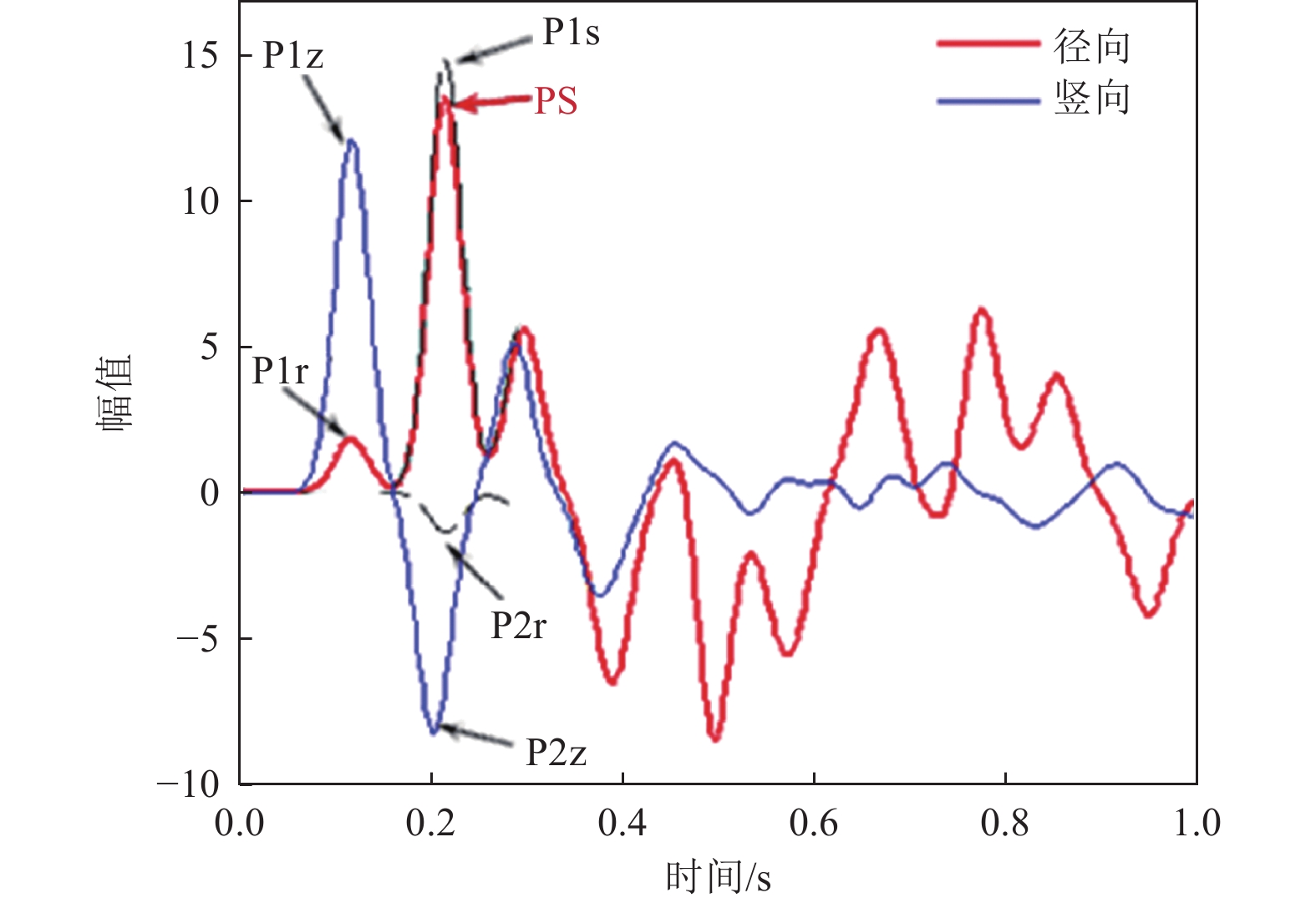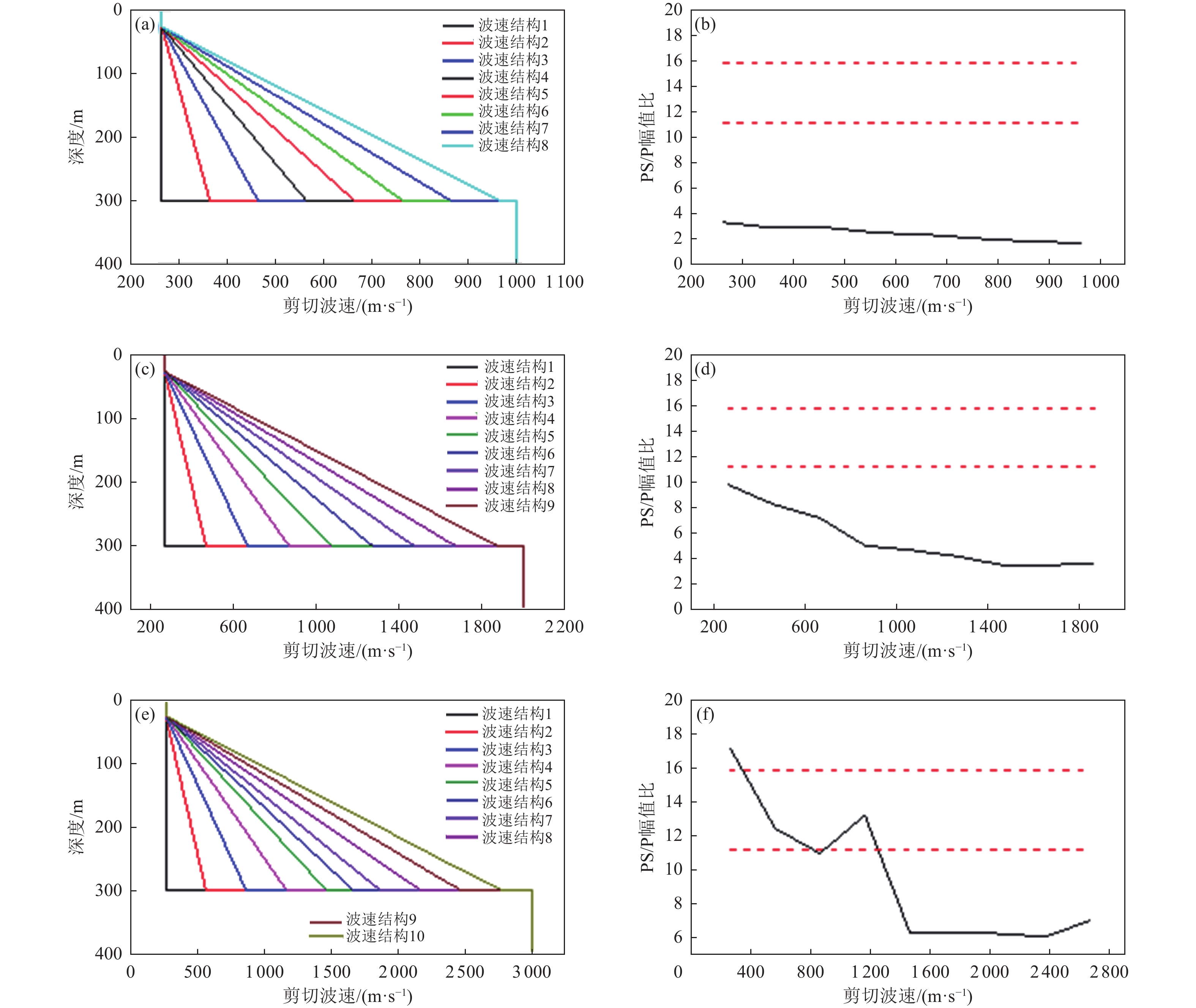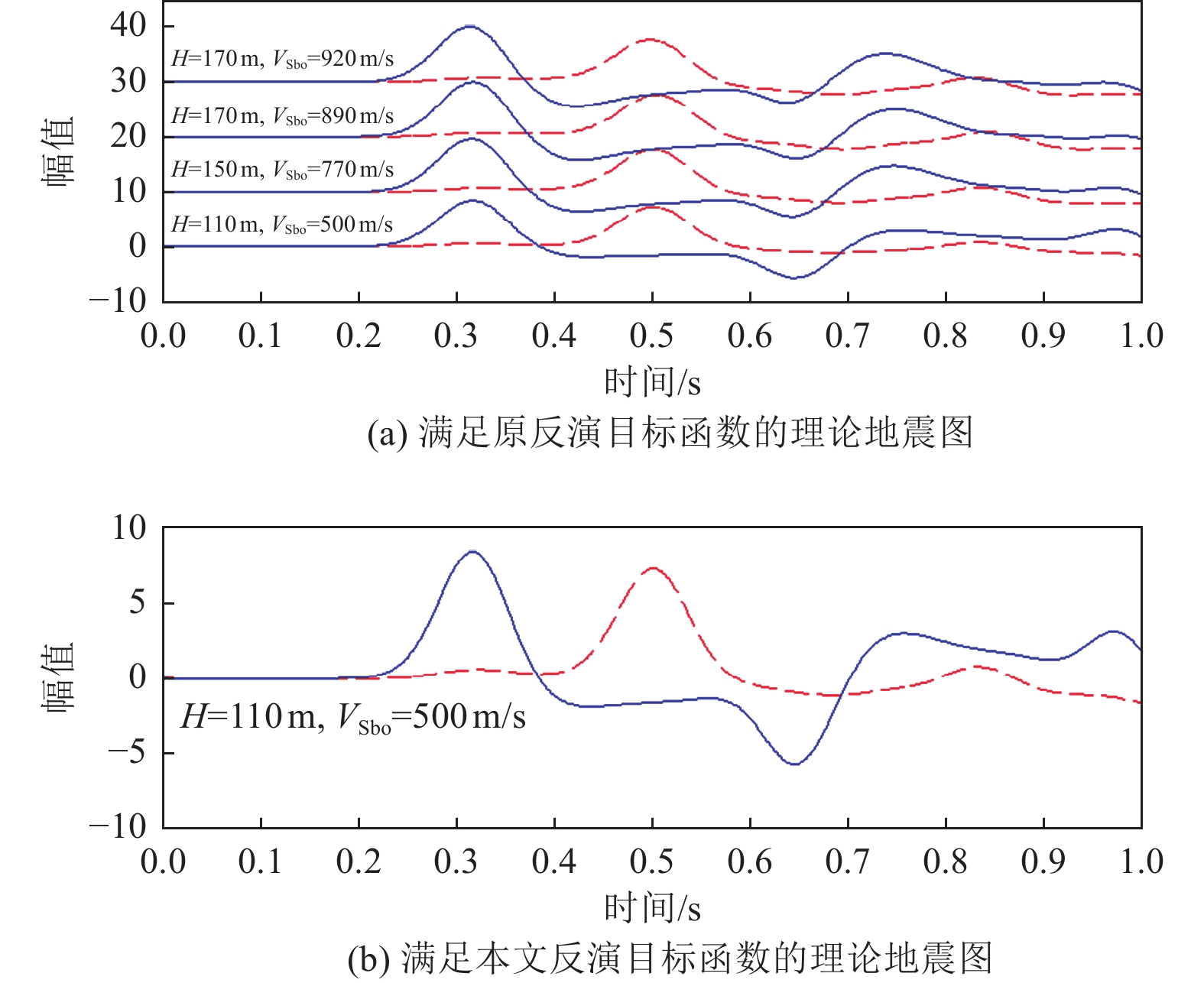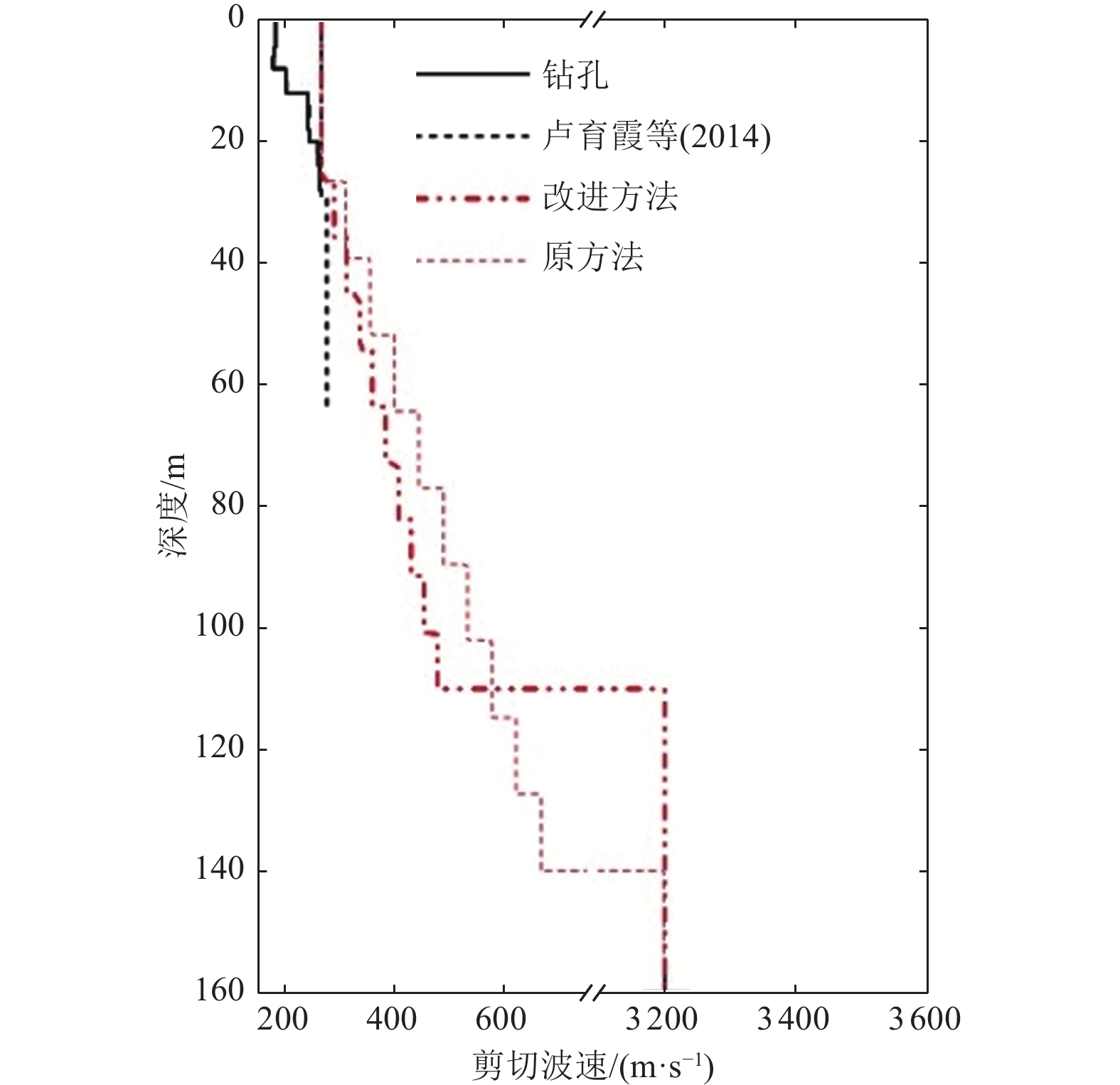Inversion of Site Velocity Structure Based on Near-field Seismic Records at Single Station
-
摘要: 基于近场加速度记录反演场地浅部速度结构,可为补充强震台站场地信息提供一种简便的途径,有利于记录的充分利用。本文详细推导了基于单一台站记录的P波地震图法,分析了其中的反演目标函数;通过数值模拟大量近场场地上的理论地震图,分析了场地覆盖层剪切波速、厚度等特征参数及震源持时对PS波与P波延时的影响,给出了地震记录的筛选原则;通过增加P波初到时刻径向分量与竖向分量幅值比函数作为反演目标函数,对单台地震图法进行改进;最后,利用汶川地震主震及余震记录,反演了武都强震台的场地波速结构,并与表面波法和钻孔法进行对比,结果表明,改进的单台地震图法搜索能力得到了增强,反演效率和精度得到显著提高。Abstract: The P-wave seismogram method offers a fast and convenient approach to investigating the velocity structure at seismic stations using near-field strong aftershock records, thus maximizing the utility of these data. This method was thoroughly derived, and its inversion objective function was analyzed. Through numerical simulations of theoretical seismograms from multiple near-field sites, the impact of site characteristic parameters and seismic source duration on the delay between the PS-wave and P-wave was examined. The applicability of the seismic records was also assessed. To improve the single-station seismogram method, the amplitude ratio between the initial vertical and radial components at the first arrival of the P-wave was incorporated as an additional inversion objective function. The improved method was then applied to invert the S-wave velocity structure at the Wudu station using mainshock and aftershock records from the Wenchuan earthquake. Comparisons with the surface wave method and the borehole method demonstrate that the enhanced single-station seismogram method improved search capability, as well as inversion efficiency and accuracy.
-
Key words:
- Shear-wave velocity /
- P-wave seismograms method /
- Seismic station /
- Inversion
-
图 1 入射P波在自由表面处的转换(Li等,2014)
Figure 1. Interaction between incident P-wave and free surface (from Li et al., 2014)
表 1 武都台记录的地震信息
Table 1. Earthquakes information of recorded at Wudu station
发震时间 纬度/
(°N)经度/
(°E)震源
深度/km震级 震中距/
km2008-07-31 13:56:03 33.3 105.1 33 3.3 15.2 2008-08-02 21:45:03 32.7 105.7 10 4.0 97.8 2008-08-31 15:24:03 32.7 105.8 10 4.1 104.4 2008-05-15 21:04:03 32.7 105.6 33 4.3 89.8 2008-05-25 17:34:03 33.0 104.9 33 4.7 37.8 2008-05-25 16:21:03 32.5 105.4 33 6.4 96.4 2008-08-05 17:49:03 32.7 105.6 10 6.5 90.9 -
陈成锋,张瑞青,强正阳等,2022. 川南泸州地区地震重定位与地壳三维速度结构研究. 地球物理学报,65(12):4672−4684. doi: 10.6038/cjg2022P0905Chen C. F., Zhang R. Q., Qiang Z. Y., et al., 2022. Seismicity and three-dimensional crustal structure of the Luzhou region in the southern Sichuan Basin, China. Chinese Journal of Geophysics, 65(12): 4672−4684. (in Chinese) doi: 10.6038/cjg2022P0905 方洪健,刘影,姚华建等,2023. 区域尺度地震体波和面波走时联合成像:进展与展望. 地球与行星物理论评(中英文),54(3):252−269.Fang H. J., Liu Y., Yao H. J., et al., 2023. Regional-scale joint seismic body- and surface-wave travel time tomography. Reviews of Geophysics and Planetary Physics, 54(3): 252−269. (in Chinese) 郝奥伟,张海江,韩守诚等,2023. 基于多台站的接收函数和重力联合反演确定莫霍面起伏和地壳平均波速比. 地震学报, 45 (1):1−16.Hao A. W. ,Zhang H. J. ,Han S. C. ,et al. ,2023. Joint inversion of multi-station receiver functions and gravity data for imaging Moho variations and average crustal v P/ v S ratios. Acta Seismologica Sinica, 45 (1):1−16. (in Chinese) 黄海波,丘学林,胥颐等,2011. 利用远震接收函数方法研究南海西沙群岛下方地壳结构. 地球物理学报,54(11):2788−2798. doi: 10.3969/j.issn.0001-5733.2011.11.009Huang H. B., Qiu X. L., Xu Y., et al., 2011. Crustal structure beneath the Xisha Islands of the South China Sea simulated by the teleseismic receiver function method. Chinese Journal of Geophysics, 54(11): 2788−2798. (in Chinese) doi: 10.3969/j.issn.0001-5733.2011.11.009 贾俊峰,杜修力,韩强,2015. 近断层地震动特征及其对工程结构影响的研究进展. 建筑结构学报,36(1):1−12.Jia J. F., Du X. L., Han Q., 2015. A state-of-the-art review of near-fault earthquake ground motion characteristics and effects on engineering structures. Journal of Building Structures, 36(1): 1−12. (in Chinese) 刘平,罗奇峰,陈兴周,2020. 汶川地震竖向地震动衰减关系. 哈尔滨工业大学学报,52(2):119−128. doi: 10.11918/201809108Liu P., Luo Q. F., Chen X. Z., 2020. Vertical ground motion attenuation relationship of Wenchuan earthquake. Journal of Harbin Institute of Technology, 52(2): 119−128. (in Chinese) doi: 10.11918/201809108 刘启元,Kind R.,李顺成,1997. 中国数字地震台网的接收函数及其非线性反演. 地球物理学报,40(3):356−368. doi: 10.3321/j.issn:0001-5733.1997.03.008Liu Q. Y., Kind R., Li S. C., 1997. The receiver functions at the stations of the Chinese Digital Seismic Network (CDSN) and their nonlinear inversion. Acta Geophysica Sinica, 40(3): 356−368. (in Chinese) doi: 10.3321/j.issn:0001-5733.1997.03.008 刘振东,吕庆田,严加永等,2012. 庐枞盆地浅表地壳速度成像与隐伏矿靶区预测. 地球物理学报,55(12):3910−3922. doi: 10.6038/j.issn.0001-5733.2012.12.004Liu Z. D., Lü Q. T., Yan J. Y., et al., 2012. Tomographic velocity structure of shallow crust and target prediction for concealed ore deposits in the Luzong Basin. Chinese Journal of Geophysics, 55(12): 3910−3922. (in Chinese) doi: 10.6038/j.issn.0001-5733.2012.12.004 卢育霞,马林伟,卢芳琴等,2014. 武都台的地震记录特征及场地条件分析. 地震工程与工程振动,34(S1):118−125.Lu Y. X., Ma L. W., Lu F. Q., 2014. Characteristics of strong ground motion and site condition on 62WUD seismic station. Earthquake Engineering and Engineering Dynamics, 34(S1): 118−125. (in Chinese) 王海云,谢礼立,2008. 近断层地震动模拟现状. 地球科学进展,23(10):1043−1049. doi: 10.3321/j.issn:1001-8166.2008.10.006Wang H. Y., Xie L. L., 2008. A review on near-fault ground motion simulation. Advances in Earth Science, 23(10): 1043−1049. (in Chinese) doi: 10.3321/j.issn:1001-8166.2008.10.006 王霞,宋美琴,王亮等,2015. 口泉断裂及其邻近地区的地壳速度结构. 地震地质,37(4):939−952. doi: 10.3969/j.issn.0253-4967.2015.04.001Wang X., Song M. Q., Wang L., et al., 2015. Study on crustal velocity structure beneath Kouquan fault and adjacent area. Seismology and Geology, 37(4): 939−952. (in Chinese) doi: 10.3969/j.issn.0253-4967.2015.04.001 肖卓,高原,2017. 利用双差成像方法反演青藏高原东北缘及其邻区地壳速度结构. 地球物理学报,60(6):2213−2225. doi: 10.6038/cjg20170615Xiao Z., Gao Y., 2017. Crustal velocity structure beneath the northeastern Tibetan plateau and adjacent regions derived from double difference tomography. Chinese Journal of Geophysics, 60(6): 2213−2225. (in Chinese) doi: 10.6038/cjg20170615 周宝峰,宋廷苏,于海英等,2014a. 芦山强震记录中的奇异波形研究. 地震工程与工程振动,34(S1):93−99.Zhou B. F., Song T. S., Yu H. Y., et al., 2014a. The study on the wizard wave in the strong motion record. Earthquake Engineering and Engineering Dynamics, 34(S1): 93−99. (in Chinese) 周宝峰,温瑞智,谢礼立,2014b. 强震记录中的“尖刺”现象初步研究. 土木工程学报,47(S2):295−299.Zhou B. F., Wen R. Z., Xie L. L., 2014b. The preliminary study on the “spike” in strong motion records. China Civil Engineering Journal, 47(S2): 295−299. (in Chinese) 周龙泉,刘杰,张晓东,2007. 2003年大姚6.2和6.1级地震前三维波速结构的演化. 地震学报,29(1):20−30. doi: 10.3321/j.issn:0253-3782.2007.01.003Zhou L. Q., Liu J., Zhang X. D., 2007. Evolution of 3D velocity structure before Dayao M 6.2 and M 6.1 earthquakes in 2003. Acta Seismologica Sinica, 29(1): 20−30. (in Chinese) doi: 10.3321/j.issn:0253-3782.2007.01.003 Aki K. , Richards P. G. , 2002. Quantitative seismology. 2nd ed. Sausalito, California: University Science Books. Chen K. C., Chiu J. M., Yang Y. T., 1996. Shear-wave velocity of the sedimentary basin in the upper Mississippi embayment using S-to-P converted waves. Bulletin of the Seismological Society of America, 86(3): 848−856. doi: 10.1785/BSSA0860030848 Chiu S. C. C., Langston C. A., 2011. Waveform inversion for one-dimensional near-surface structure in the New Madrid seismic zone. Bulletin of the Seismological Society of America, 101(1): 93−108. doi: 10.1785/0120100025 Kim B., Hashash Y. M. A., Rathje E. M., et al., 2016. Subsurface shear wave velocity characterization using P -Wave seismograms in central and eastern North America. Earthquake Spectra, 32(1): 143−169. doi: 10.1193/123013EQS299M Langston C. A., 2003. Local earthquake wave propagation through Mississippi embayment sediments, part I: body-wave phases and local site responses. Bulletin of the Seismological Society of America, 93(6): 2664−2684. doi: 10.1785/0120030046 Li Z. W., Ni S. D., Somerville P., 2014. Resolving shallow shear-wave velocity structure beneath station CBN by waveform modeling of the Mw 5.8 mineral, Virginia, earthquake sequence. Bulletin of the Seismological Society of America, 104(2): 944−952. doi: 10.1785/0120130190 Ni S., Li Z., Somerville P., 2014. Estimating subsurface shear velocity with radial to vertical ratio of local P waves. Seismological Research Letters, 85(1): 82−90. doi: 10.1785/0220130128 Randall G. E., 1989. Efficient calculation of differential seismograms for lithospheric receiver functions. Geophysical Journal International, 99(3): 469−481. doi: 10.1111/j.1365-246X.1989.tb02033.x Zhu L. P., Rivera L. A., 2002. A note on the dynamic and static displacements from a point source in multilayered media. Geophysical Journal International, 148(3): 619−627. doi: 10.1046/j.1365-246X.2002.01610.x -




 下载:
下载:











